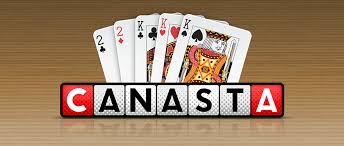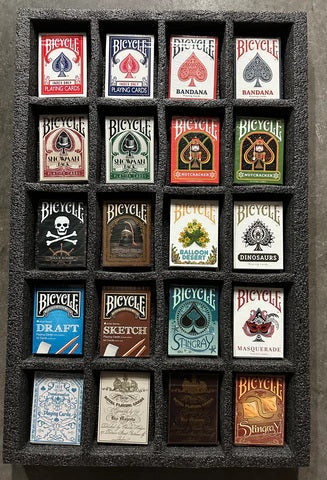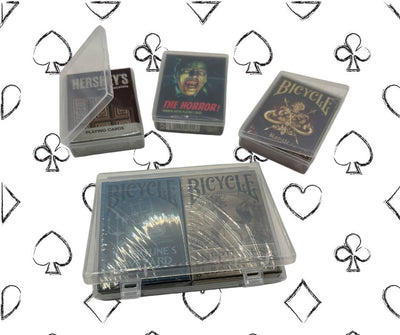(A typical game of Canasta in action)
Card Game Rules
Canasta is a Rummy type game of melding that is played with two 52 playing card decks and two teams of 2. The objective of Canasta is for your team to reach 5000 points first.
For other Rummy type games, see our guides for Classic Rummy and Gin.
If you are looking for cards to play Canasta with, check out a standard pack here or one of our more recent arrivals here.
Set Up
Before the game begins an initial dealer must be chosen. To do so, every player is given a card from a shuffled deck and whoever receives the highest card becomes the first dealer. Ties are broken by a repeated deal. The initial dealer shuffles the deck and the player to their right cuts it. The dealer then passes 11 cards one by one clockwise to each of the four players. The remaining cards are placed faced down to form the stock. The top card of the stock is turned upright and placed to the side to form the discard pile. The dealer position rotates clockwise at the end of each round.
Teammates sit across from each other and work together to form more melds than the other team.
Melding
Melds are formed by matching cards of the same rank. A meld must begin with at least three cards.
Wildcards
The four Jokers and eight 2’s in the deck are wildcards and can be used to build upon any meld. Melds must have, however, more natural cards than wildcards in them.
How to Play
The gameplay moves clockwise from the dealer. At the beginning of their turn they must take a card from either the stock or the discard pile. To take a card from the discard pile, the top card must either help begin a meld or build upon one already made. If you take from the discard pile, you must take all of the cards in the discard pile. At the end of your turn, you must discard one card.
Players continue to build upon melds in hopes to get a canasta, a meld of seven or more cards. Once a team has at lease one canasta and one of the players runs out of their cards, they can “go out” and end the round.
Scoring
Points are given in 4 ways: Card Values, Canastas, Red 3’s, and Going Out.
Card Values
In Canasta, Jokers are worth 50 points, Aces and 2’s are worth 20 points, Kings through 8’s are worth 10 points and 7’s through 4’s and black 3’s are worth 5 points. Points are given from the difference between melded cards and unmelded cards.
Canastas
A canasta without any wildcards is worth an additional 500 points while a canasta with wildcards is worth an additional 300 points.
Red 3’s
Each red 3 is worth 100 points. If a team has all of the red 3’s, however, they receive 800 points
Going Out.
The team that goes out and ends the round receives an additional 100 points.
Additional Rules
- If a player has a red 3 in their hand, they must immediately place it on the table along with the melds.
- The first meld a player makes must have a minimum meld value depending on the team’s current score. For a team score of 0-1499, the first meld of a player must be at least 50 points. For a team score of 1500-2999, the first meld of a player must be at least 90 points. For a team score of 3000+, the first meld of a player must be at least 120 points.
- The discard pile can become frozen (i.e. nobody can take from it) if a player decides to discard a wildcard. The discard pile can become unfrozen if a player can make a natural meld with the top card in the pile.
For more resources on the rules of Canasta, check out pagat's article on the game here and gathertogethergame's article here.
(A guide to the game of Canasta)
History
In 1939, Canasta was invented by Segundo Santos and Alberto Serrato who wanted to create a quicker game than bridge. Canasta in Spanish means “basket” and refers to the basket Santos and Serrato normally put their cards in. The game was an instant success in their local card clubs but, became a global sensation in the 1950’s. Countless books were written on the game then, specialty decks were sold and Canasta overtook Bridge as the popular pastime.
For more information on the history of Canasta, check out game developer Philip E. Orbanes' article here.
Variations
Two Player
In Two Player Canasta, 15 cards are initially dealt. If a player draws from the stock, they must draw two cards instead of the normal one. Additionally, a player needs to complete two canastas in order to go out and end the round. All other rules of Classic Canasta apply including the 5000 point objective.
Samba
Samba is practically Classic Canasta but, with increased values for everything. Three 52 card decks are in play, totaling 162 cards. Instead of a 5000 point objective, teams have to reach 10000 points. Melds can be made by cards of a kind and cards in sequence. Six red 3’s are worth 1000 points. Melds can only have two wildcards in them. For teams with 7000 points or more, the first meld of a player must be least 150 points.
Miscellaneous Rules
Games might also implement a number of rules such as:
- A natural canasta of 7’s is worth 2500
- A canasta of wildcards is worth 2000
- A mixed canasta of 7’s is a penalty of 2500
- If players have three or more Aces in their hand at the end of the round, there is a penalty of 1500.
Looking for more card games to play? Check out this article:
40+ Great Card Games For All Occasions
About the author: John Taylor is a content writer and freelancer through the company Upwork.com. You may view his freelancing profile here. He has a B. A. in English, with a specialty in technical writing, from Texas A&M University and a M. A. in English from the University of Glasgow. You may view his previous articles about card games here and his LinkedIn profile here.








35 comments
If 2 people want to play canasta instead of the 4 do you deal 15 cards each? And when It’s our turn to pick We pick 2 cards not one?? Do we just play the same individually with melding
Thank you
David – Here’s my understanding: After the cards are dealt, anyone who has a red three in his hand places it face up on the table in front of him. Then starting with the person to the left of the dealer, each person in turn takes a card from the stock for each three he has laid down. If the stock card is another red three, that is placed down and another card is taken. So when the play comes to you, you should not have red threes in your hand. Proceed with your meld with the top card of the discard pile,pick up the rest of the pile, and have fun!
If I have one card in my hand, then at my turn, I draw a card. One will play on my meld, but since I cannot discard, can I ‘pass’?
Question
I have two red threes in my hand. It is my turn to play and wish to pick up the discard pile to make my initial meld.
Do I place the red threes on the table and replace them from the stock pile. And proceed with my initial meld. Or some thing different?